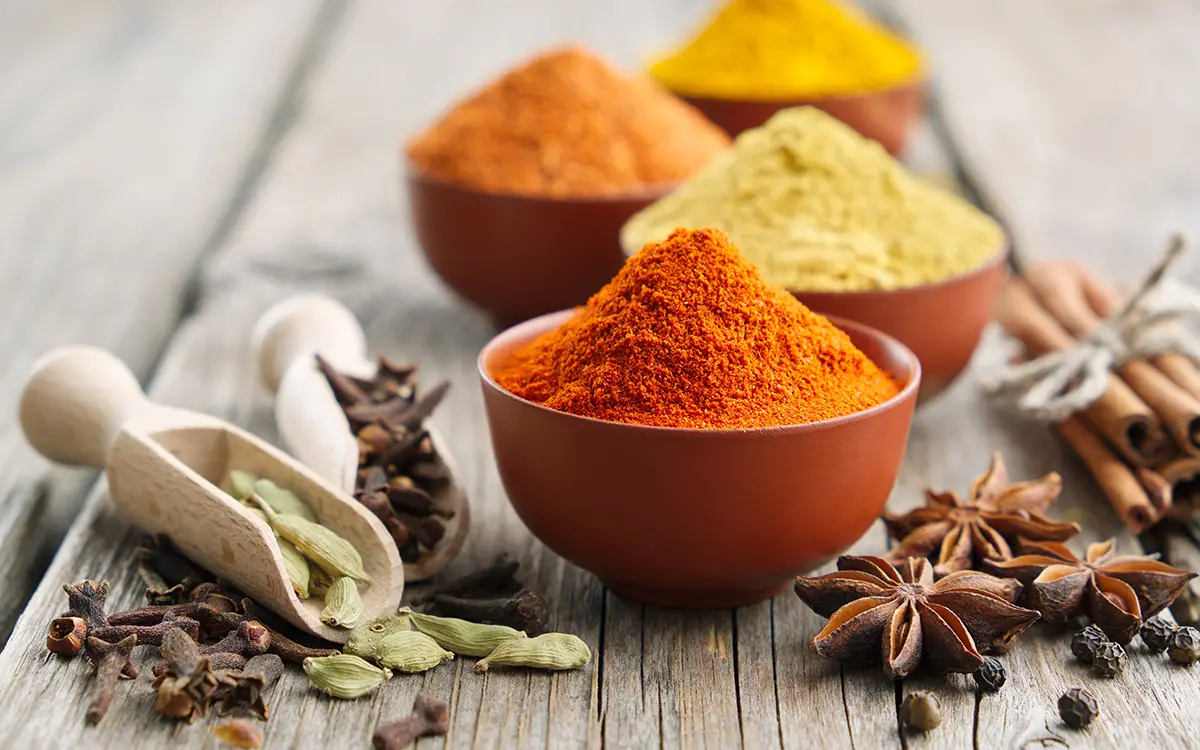new to the gluten free journey?
new to the gluten free journey?

Eating a healthy gluten free diet means eating lots of fresh whole foods, like high quality meats, fish, and eggs, vegetables and fruit, and nuts and seeds. A great way to add some flavor to these otherwise simple foods is with herbs and spices.
But of course, it is important to make sure that anything you add to your food during or after cooking is also gluten free. So it is important to evaluate herbs and spices before using them.
Contents
ToggleBefore we dive into whether spices are gluten free or not, it’s important to first understand what gluten is. Gluten is a protein that is found in grains such as wheat, barley, and rye. It gives bread and other baked goods an elastic texture and helps them to rise.
For people with celiac disease or non celiac gluten sensitivity, consuming gluten causes inflammation, and can cause a range of symptoms, from gastrointestinal distress like bloating and diarrhea, to full blown autoimmune diseases like celiac, rheumatoid arthritis, and hypothyroidism.
Spices in their simple and unadulterated form are naturally gluten free. However, many companies add fillers to spices in order to bulk up the volume of the spice or herb which dilutes the amount of actual spice in an effort to increase profit margin. Fillers may also be added to make spices last longer or to prevent clumping.
Unfortunately, these fillers are generally not good for our bodies and many fillers can contain gluten. In addition, some spice fillers or additives may increase the risk of autoimmune issues including celiac disease.
In addition to powdered spices, liquid spice extracts like vanilla extract that are used frequently in baking can contain unwanted additives. One of the most common additions is alcohol, which is used to preserve the extract. However, many of these alcohols are grain based and should be investigated. You can purchase an alcohol free extract or make your own at home.
In addition, watch out for “imitation” flavors. While true extracts are made from the source itself (like a vanilla bean), imitation flavors are not. For example, imitation vanilla is made from vanillin, which is manufactured from a substance called guaiacol. Most of the world’s guaiacol supply comes from petroleum. The vanillin is diluted with a liquid (usually either alcohol or propylene glycol). Then, it is often colored to make it appear like a true extract. Caramel coloring is commonly used for this. Caramel coloring can be derived from grains like wheat and corn.
As always, it is important to be aware of cross-contamination. Cross contamination can happen when the same equipment is used to produce or package your spices or herbs that is used to produce or package other gluten-containing products. Cross contamination may also occur in a restaurant setting. For example, a cook might use the same hand or scoop to include spices in your dish (or as a garnish) that they use for a gluten containing ingredient.
To help mitigate risk, we recommend never buying bulk spices from stores that you fill up your own containers. This can lead to accidental cross contamination from spices that aren’t gluten free!
Organic herbs and spices are a better choice for those with celiac disease and non celiac gluten sensitivity. Organic herbs and spices aren’t sprayed with the same toxic chemicals (like glyphosate) that conventional spices can be. It is best to avoid these chemicals for a number of health reasons, but especially for those with celiac disease or otherwise compromised gut health, as there is a correlation between glyphosate exposure and increased incidence of celiac disease as well as GI induced inflammation.
We recommend the following brands that are organic and certified gluten free:
Being aware of your ingredients – even those that feel as minor as herbs and spices – is the first step to having a healthy gluten-free diet and to prevent the negative effects and symptoms of celiac disease and gluten sensitivities.
If you are unsure if your symptoms are related to gluten, take our free gluten sensitivity test!
Stay up-to-date with the latest articles, tips, recipes and more.

*These statements have not been evaluated by the Food and Drug Administration. This product is not intended to diagnose, treat, cure or prevent any disease.
If you are pregnant, nursing, taking medication, or have a medical condition, consult your physician before using this product.
The entire contents of this website are based upon the opinions of Peter Osborne, unless otherwise noted. Individual articles are based upon the opinions of the respective author, who retains copyright as marked. The information on this website is not intended to replace a one-on-one relationship with a qualified health care professional and is not intended as medical advice. It is intended as a sharing of knowledge and information from the research and experience of Peter Osborne and his community. Peter Osborne encourages you to make your own health care decisions based upon your research and in partnership with a qualified health care professional.
2 Responses
Thank you Dr Osbourne, I am gathering lots of information from you & your collegues. I have already bought your book, Ho pain No grain which is great, I am also considering taking the Genetic test, as my practitioner said I am not Celiac, but that I do have a problem with Gluten. I have been eating gluten free since last year now, but have not got it altogether right! yet!! I know I get bloating, wind & severe skin itching & when I don’t eat Gluten they subside. I am seeing my Keinsiologist on Wed to check my vit levels again which were good last time I had a visit in the Summer. Thank you again, I will check the herbs, as I use alot Carol P
thank you for this information. i make my own spice blends with spices i buy from the market. i usually try to get organic. i’m glad to see on the “ok” list most of the things i use.